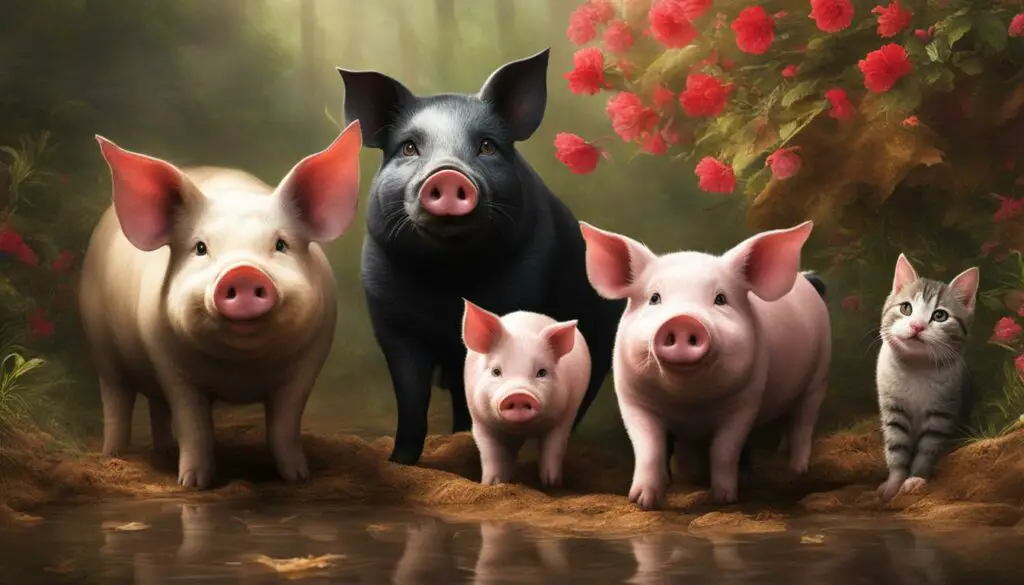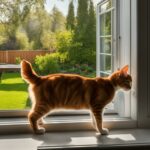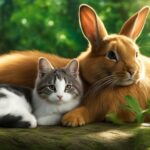As a pet owner and animal lover, I have always been fascinated by the unique dynamics between different species. One particularly intriguing relationship that caught my attention is the bond between cats and pigs. These two domesticated animals, despite their differences in size and appearance, can actually coexist harmoniously in our homes.
When it comes to cats, we are familiar with their various breeds, their dietary needs, and the importance of providing them with proper care and attention. Similarly, pigs have their own distinct breeds, dietary requirements, and care routines. Understanding the behavior and needs of both cats and pigs is crucial in ensuring their well-being and creating a nurturing environment for them.
Whether you are considering cat ownership, pig ownership, or even both, it is important to explore the unique dynamics between cats and pigs. By gaining a deeper understanding of their behavior and needs, we can create a harmonious and fulfilling life for these remarkable creatures.
Key Takeaways:
- Cats and pigs can form a harmonious relationship in multi-species households.
- Understanding the behavior and needs of cats and pigs is crucial for their well-being.
- Both cats and pigs have specific dietary requirements and care routines.
- Exploring the dynamics between cats and pigs can enhance our appreciation for these domesticated animals.
- Creating a nurturing environment is essential for the happiness of both cats and pigs.
The Complex Relationship Between Cats and Small Rodents
When it comes to cats and small rodents like hamsters or bunnies, their relationship can be quite complex. Cats have a natural hunting instinct, which can pose a challenge when trying to introduce them to these smaller pets. However, the compatibility between cats and small rodents can depend on several factors.
The Temperament of Cats
The temperament of the cat plays a crucial role in determining their compatibility with small rodents. Some cats may have a stronger prey drive and be more likely to view small rodents as potential prey. On the other hand, some cats may be more laid-back and less interested in hunting. It’s important to consider the individual cat’s personality when deciding to introduce them to small rodents.
The Age of Introduction
The age at which a cat is introduced to small rodents can also impact their compatibility. Kittens who grow up around small rodents may be more likely to view them as companions rather than prey. Older cats, especially those who have never been exposed to small rodents before, may have a harder time adjusting to their presence. Gradual introductions and supervised interactions can help older cats become acclimated to small rodents.
Ensuring Cat and Rodent Compatibility
Before introducing cats and small rodents, it’s essential to ensure the safety and well-being of both pets. Keeping the small rodents in secure enclosures that cats cannot access unsupervised is crucial. Providing plenty of hiding spots, elevated areas, and escape routes for small rodents can help mitigate potential conflicts. Understanding the natural behaviors of both cats and small rodents can also help create an environment that promotes compatibility and reduces stress.
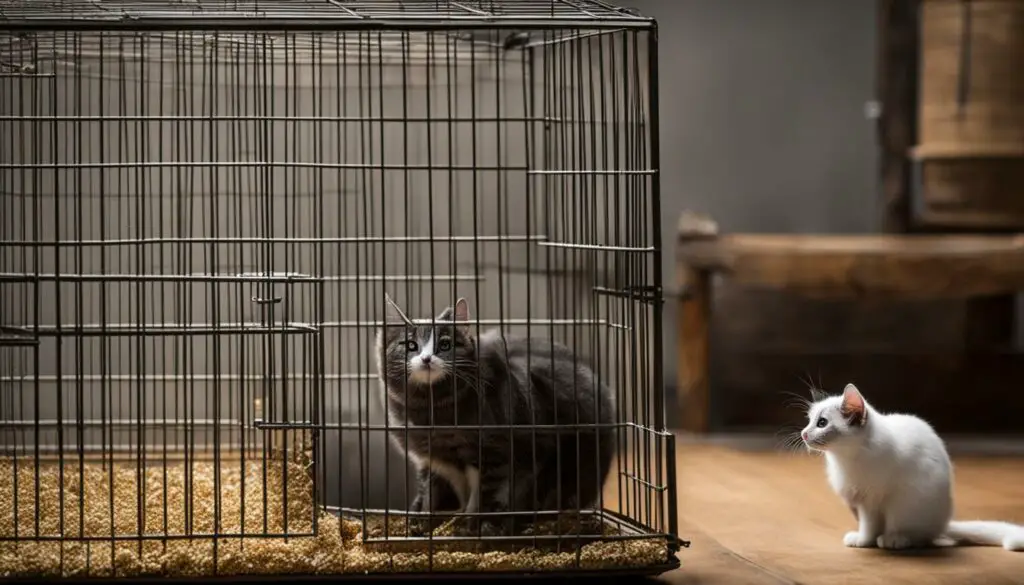
| Cat Breeds | Temperament |
|---|---|
| Maine Coon | Gentle, adaptable |
| Siamese | Curious, vocal |
| Bengal | Energetic, playful |
By considering the temperament of cats, the age of introduction, and implementing measures to ensure compatibility, it is possible to create a safe and harmonious environment for both cats and small rodents in a multi-species household.
The Friendship Between Cats and Rabbits: Can It Happen?
When it comes to introducing cats and rabbits, there is often curiosity and speculation about whether these two species can form a genuine friendship. While it may seem unlikely due to their different behaviors and communication styles, many pet owners have discovered that cats and rabbits can indeed coexist and even bond with each other.
When introducing cats and rabbits, it’s crucial to provide a controlled and supervised environment. Start by allowing the rabbit to assert their dominance in the first meeting. This can help establish a hierarchal structure and prevent any potential aggression from the cat. Gradual integration is key, as it allows both animals to become familiar with each other’s scent and presence.
Supervised playtime is an important aspect of fostering a positive relationship between cats and rabbits. Encourage interactive play with toys and treats, ensuring that both animals are engaged and content. It’s essential to observe their interactions closely and intervene if any signs of aggression or discomfort arise.
“I was initially hesitant about introducing my cat to a rabbit, but with patience and careful supervision, they have become the best of friends. They often groom each other and snuggle together. It’s a heartwarming sight!” – Cat and Rabbit Owner
Remember, every cat and rabbit is unique, and their compatibility can vary. It’s crucial to consider their individual personalities and temperaments when introducing them. With proper guidance and attention, a friendship between a cat and rabbit can blossom, creating a harmonious and delightful multi-species household.
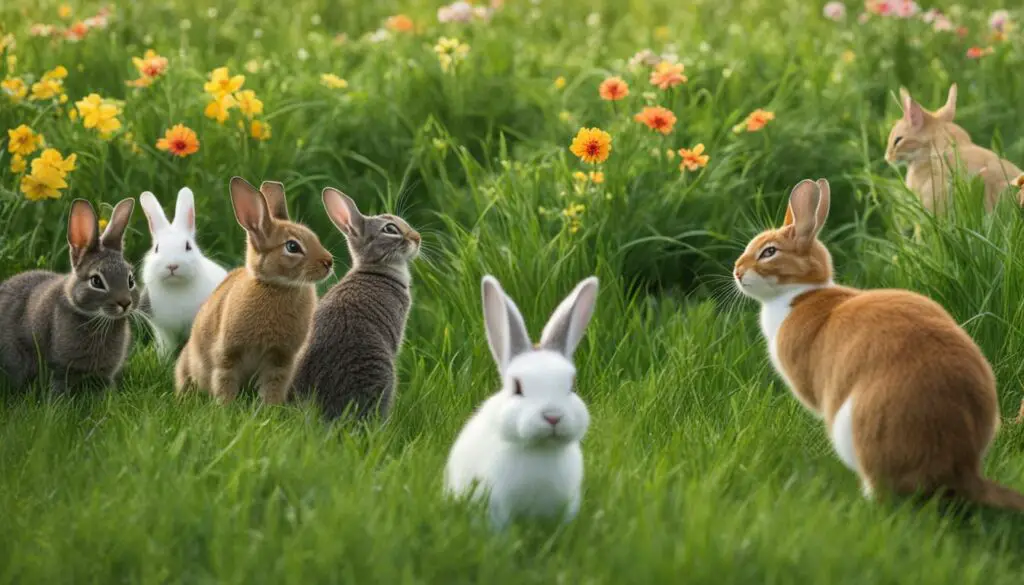
Cats and Guinea Pigs: A Delicate Relationship
When it comes to keeping cats and guinea pigs together, it’s important to prioritize the safety and well-being of both animals. While guinea pigs are cheerful and social pets, and cats are known for their curiosity and playfulness, their relationship requires careful management to prevent any unintentional harm.
Cat and guinea pig safety should be the top priority when considering their coexistence. Guinea pigs should have a secure and well-ventilated cage that is out of reach of the cat. This will prevent any potential accidents or injuries that could occur if the cat were to try to access the guinea pig’s enclosure. Additionally, it’s essential to closely supervise any interactions between the cat and guinea pig to ensure the safety of both animals.
Cat and guinea pig playtime can be a wonderful opportunity for both pets to socialize and bond. However, it’s important to create a secure play area where the guinea pig can feel safe and the cat can be closely monitored. This will prevent the cat from accidentally chasing or pouncing on the guinea pig, which could lead to stress or injury. Regular play sessions should be short and supervised to ensure a positive and controlled experience for both pets.
By prioritizing safety, providing secure enclosures, and closely supervising interactions and playtime, it is possible to create a harmonious relationship between cats and guinea pigs. With careful management and consideration for the needs of both animals, you can foster a safe and enriching environment for your beloved pets.
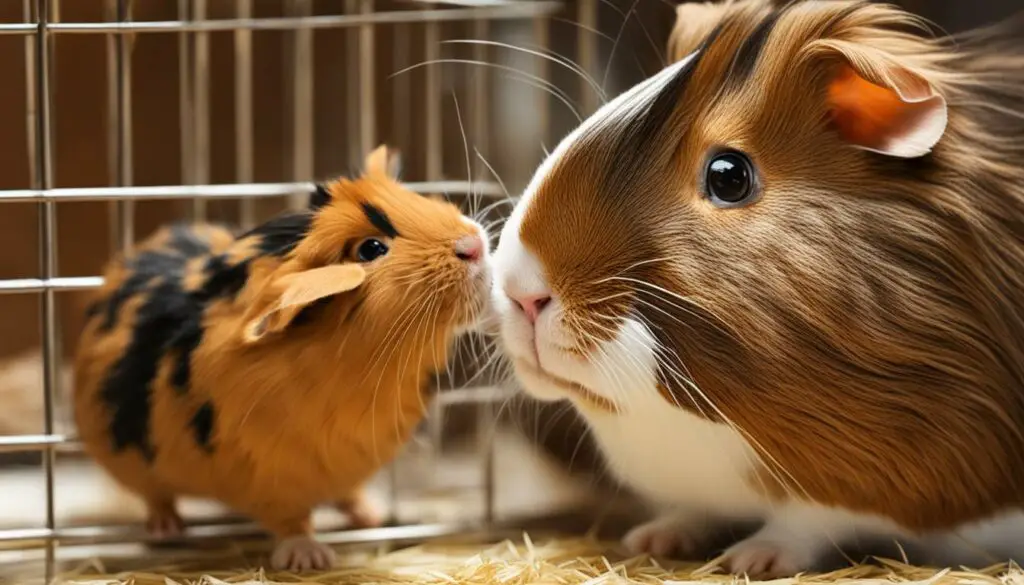
| Keeping Cats and Guinea Pigs Together – Safety Tips | Benefits of Cat and Guinea Pig Playtime |
|---|---|
|
|
Cats and Small Rodents: Navigating Interactions and Ensuring Safety
When it comes to cats and small rodents like hamsters, rats, and mice, understanding their interactions and ensuring their safety is crucial in maintaining a harmonious household. Cats have natural hunting instincts that can pose a challenge when introducing them to small rodents, but with proper precautions, they can coexist peacefully.
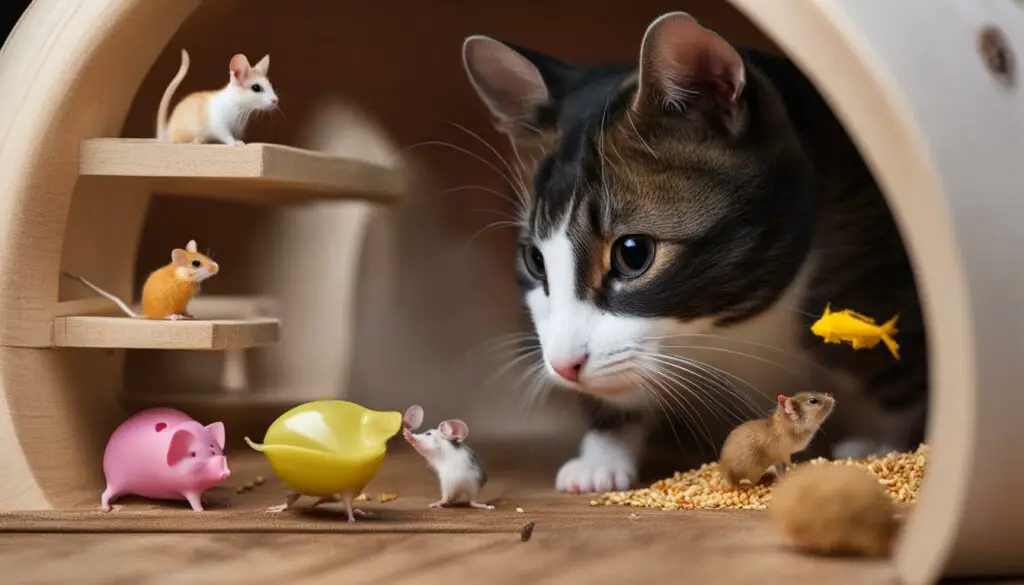
Interactions between cats and hamsters require careful supervision. Hamsters should be kept in secure cages that are inaccessible to cats. It’s essential to provide separate living spaces for each pet to prevent any potential harm. When allowing them to interact, it’s crucial to closely monitor the situation and intervene if necessary.
Similarly, when it comes to cats and rats or mice, their interactions should be carefully managed. Implementing proper enclosure setups for rats and mice is essential. These enclosures should be secure and inaccessible to cats, ensuring the safety of both pets.
Key Safety Measures for Cats and Small Rodents:
- Keep small rodents in secure cages, away from cats’ reach.
- Provide separate living spaces for cats and small rodents.
- When allowing interactions, closely supervise and intervene if necessary.
- Create secure enclosures for rats and mice to prevent access by cats.
By taking these safety measures, we can foster an environment where cats and small rodents can coexist, allowing both pets to thrive without compromising their well-being.
| Small Rodent | Interactions with Cats | Safety Measures |
|---|---|---|
| Hamsters | Require careful supervision; should be kept in a secure cage away from cats | Provide separate living spaces; closely monitor interactions |
| Rats and Mice | Interactions should be carefully managed; cats should not have access to their enclosures | Create secure enclosures; ensure cats cannot reach the rats or mice |
A Clowder of Cats: Unity and Harmony
When cats come together in a group, they form what is known as a clowder. This collective noun for cats perfectly captures the essence of their social dynamics and the unity they can exhibit in their interactions. Within a clowder, each cat plays a unique role, contributing to the overall harmony of the group.
Feline social dynamics are fascinating to observe. Cats establish hierarchies within the clowder, with dominant and submissive individuals. This hierarchical structure helps maintain order and reduce conflicts among the group. Dominant cats typically take charge and make decisions, while subordinate cats follow their lead.
While there may be occasional squabbles within the clowder, cats generally have a remarkable ability to coexist peacefully. They engage in mutual grooming, which not only helps them bond but also reinforces social bonds and reduces tension. Cats also engage in play together, providing mental stimulation and exercise while strengthening social connections.
| Benefits of a Clowder of Cats | Challenges of a Clowder of Cats |
|---|---|
|
|
“A clowder of cats is a charming sight, showcasing the unique social dynamics and unity that cats can achieve. It is a testament to their adaptable nature and their ability to form deep bonds with their feline companions.”
As a cat owner, understanding the social dynamics within a clowder is essential for creating a harmonious environment. Providing ample resources such as food, water, litter boxes, and resting areas is crucial to prevent conflicts over limited resources. Additionally, regular veterinary care, proper nutrition, and individual attention are essential to ensure the well-being of each cat within the clowder.
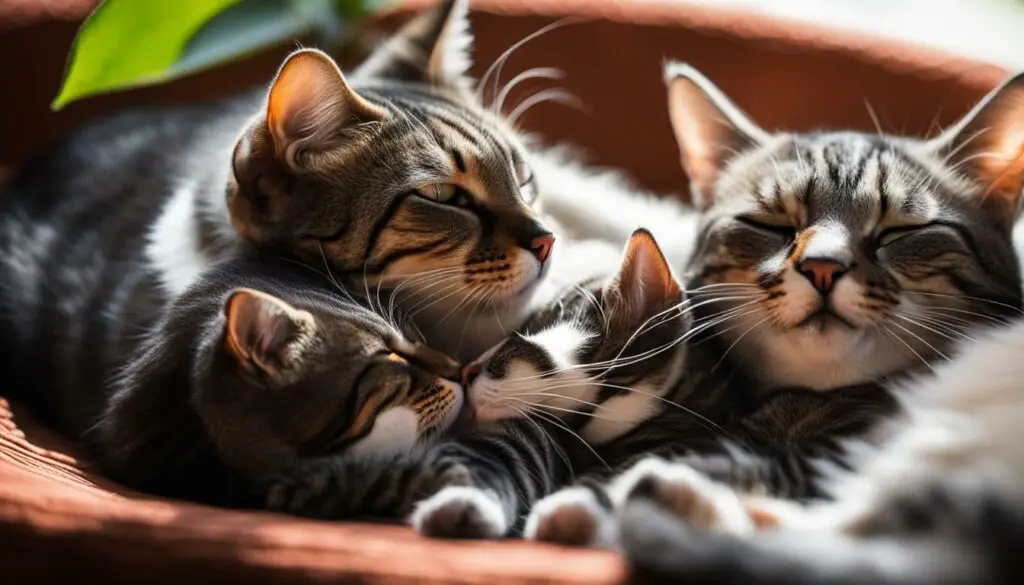
The Beauty of a Clowder of Cats
The unity and harmony displayed within a clowder of cats is truly something to behold. From their social interactions to their unmistakable bond, a clowder of cats is a living testament to the magical dynamics of feline companionship.
Cats and Cattle: An Unexpected Relationship
When we think of cats as pets, we often imagine them curled up on our laps or playfully chasing a feather toy. But did you know that cats can also have unexpected interactions with cattle? While it may seem like an unlikely pairing, cats and cattle can develop unique relationships in shared spaces.
One reason for this surprising connection is that cats are naturally curious animals. They are known for their ability to adapt to various environments and explore their surroundings. This curiosity can lead them to be intrigued by large animals like cattle, observing their movements and behaviors with great interest.
“Cats and cattle can form a mutually beneficial bond, as cats can help control rodent populations around the farm while finding companionship in the presence of these gentle giants.”
In turn, cattle can also be accepting of cats’ presence. Their calm and gentle nature makes them less likely to be bothered by the presence of a feline companion. Some cats even enjoy lounging near the warm bodies of cattle, using them as a cozy spot for relaxation.
The Benefits of Cat and Cow Interaction
While it may seem like a simple interaction, the relationship between cats and cattle can have practical benefits as well. Cats are natural hunters and are known for their ability to catch rodents. On farms, this can be especially valuable, as rodents can damage crops and spread disease. When cats roam freely around cattle, they can help keep the rodent population in check, creating a healthier environment for both the livestock and the humans who care for them.
Additionally, the calming presence of cattle can have a positive impact on cats’ well-being. Spending time around these gentle giants can reduce stress and anxiety in cats, providing them with a sense of comfort and security. This can be particularly beneficial for cats that may have experienced trauma or are in need of extra emotional support.
| Cat and Cow Interaction | Benefits |
|---|---|
| Observing cattle movements and behaviors | Stimulates cats’ curiosity and provides mental stimulation |
| Cats hunting rodents on farms | Controls the rodent population, protecting crops and preventing disease |
| Cats finding companionship with cattle | Reduces stress and provides emotional support for cats |
In conclusion, the relationship between cats and cattle may be unexpected, but it can be a mutually beneficial one. Both animals can find companionship and practical advantages in each other’s presence. So, the next time you spot a cat lounging near a cow in a meadow, remember that their connection goes beyond mere chance encounters – it’s a unique bond of curiosity and mutual benefit.
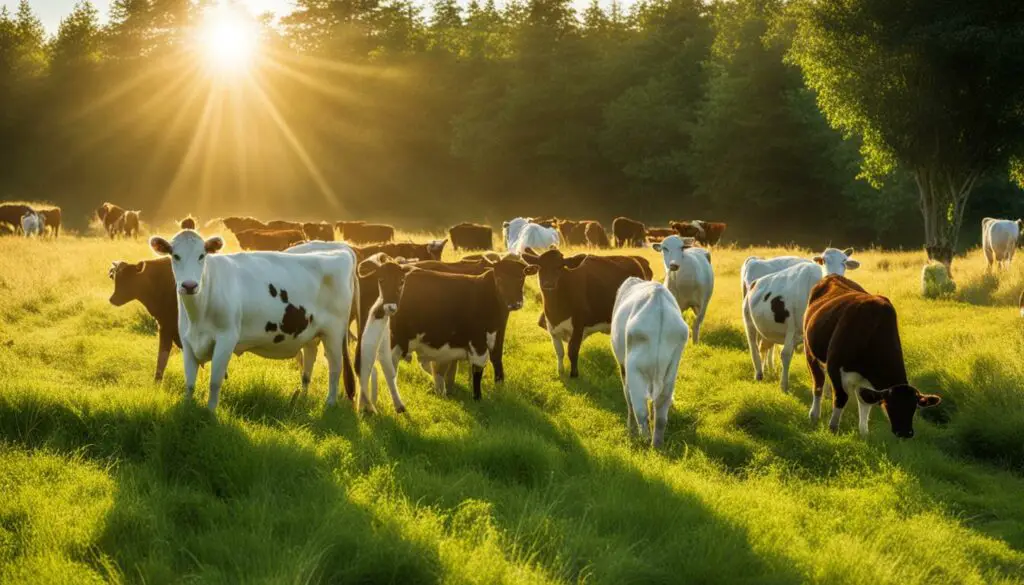
Cats and Cheetahs: Understanding Their Social Structure
When it comes to feline social behavior, cats and cheetahs display fascinating dynamics. While domestic cats have adapted to living in close proximity to humans, cheetahs thrive in the wild, exhibiting unique behaviors that contribute to their survival. Understanding these social structures can provide valuable insights into the potential interactions between cats and cheetahs.
Cheetahs are known for their solitary nature, with adult males typically leading solitary lives while females may form small groups with their offspring. Unlike domestic cats, cheetahs don’t have a hierarchical social structure. Instead, they rely on mutual tolerance and non-aggressive interactions to coexist peacefully. This adaptability allows cheetahs to live in close proximity to each other without conflict.
“Cheetahs are highly collaborative animals, often forming small groups with their own offspring. They do not exhibit the same territorial behaviors as domestic cats, which allows them to tolerate the presence of other individuals.”
When it comes to interactions between domestic cats and cheetahs, it’s important to remember that cheetahs are wild animals and should not be kept as pets. However, educational programs and wildlife conservancies provide opportunities for cats and cheetahs to interact in controlled environments. These interactions help raise awareness about cheetah conservation and provide enrichment for both cheetahs and domestic cats in a safe and supervised setting.
Understanding the social behavior of cheetahs allows us to appreciate the unique dynamics between cats and these magnificent wild felines. While they may not interact on a day-to-day basis, the shared ancestry and underlying instincts provide a basis for curiosity and fascination in observing their interactions.
| Cat Behavior | Cheetah Behavior |
|---|---|
| Domesticated cats have adapted to living in close proximity to humans and forming social bonds with their owners. | Cheetahs are highly adaptable and live in a wider range of habitats, often tolerating the presence of other individuals. |
| Domestic cats have a hierarchical social structure within a clowder, with dominant and subordinate individuals. | Cheetahs do not have a hierarchical social structure and rely on mutual tolerance and non-aggressive interactions. |
| Domestic cats exhibit territorial behaviors and mark their territory with scent markings. | Cheetahs do not exhibit territorial behaviors and can tolerate the presence of other cheetahs in close proximity. |
| Domestic cats have a diverse range of breeds and variations in behavior, size, and appearance. | Cheetahs have a distinct appearance with their slender body, spotted coat, and tear marks on their face. |
By understanding the social behavior of cats and cheetahs, we can gain a deeper appreciation for the diversity of feline species and their ability to navigate their respective environments. While domestic cats and cheetahs may not interact directly in most situations, the shared characteristics and behaviors provide a fascinating glimpse into the broader world of feline dynamics.
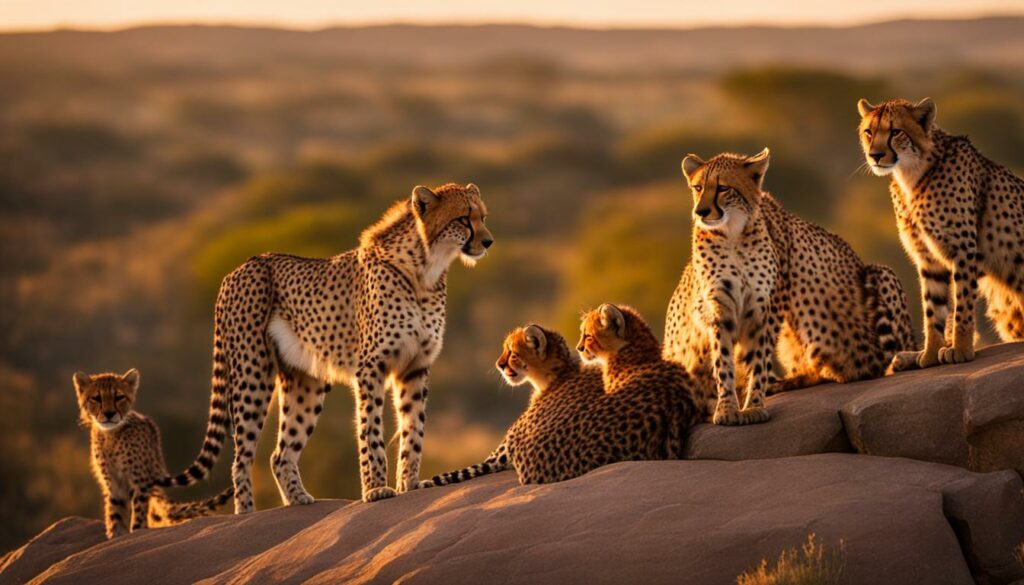
A Clowder of Chinchillas: Cute and Cuddly Companions
Chinchillas are not only adorable creatures but also highly social animals that thrive in groups. A collective noun used to describe a gathering of chinchillas is a “clowder.” These clowders of chinchillas engage in playful behaviors, mutual grooming, and exhibit a strong sense of community. Understanding chinchilla social behavior is key to providing them with the companionship and environment they need to flourish.
Chinchillas form close-knit bonds within their clowders, relying on each other for grooming, warmth, and play. Their social interactions are fascinating to observe, as they engage in activities such as chasing, popping, and rolling around. Chinchillas also communicate through a variety of vocalizations, including chirping and barking, which serve as forms of expression and socialization.
When introducing chinchillas to a new clowder, it’s essential to do so gradually and under supervised conditions. This allows them to establish their hierarchy and avoid potential conflicts. Providing ample space, stimulating toys, and a proper diet are all crucial elements in maintaining a harmonious clowder of chinchillas.
“Chinchillas are highly social animals that thrive in the company of their fellow chinchillas. Observing a clowder of chinchillas interact and play together is a heartwarming sight, reminding us of the importance of companionship in their lives.”
The Table below summarizes key aspects of chinchilla social behavior:
| Aspect | Description |
|---|---|
| Social Structure | Chinchillas live in clowders and form close-knit bonds within their group. |
| Communication | Chinchillas use various vocalizations, such as chirping and barking, to interact with each other. |
| Play Behavior | Chinchillas engage in playful activities such as chasing, popping, and rolling around. |
| Grooming | Chinchillas groom each other as a form of social bonding and hygiene maintenance. |
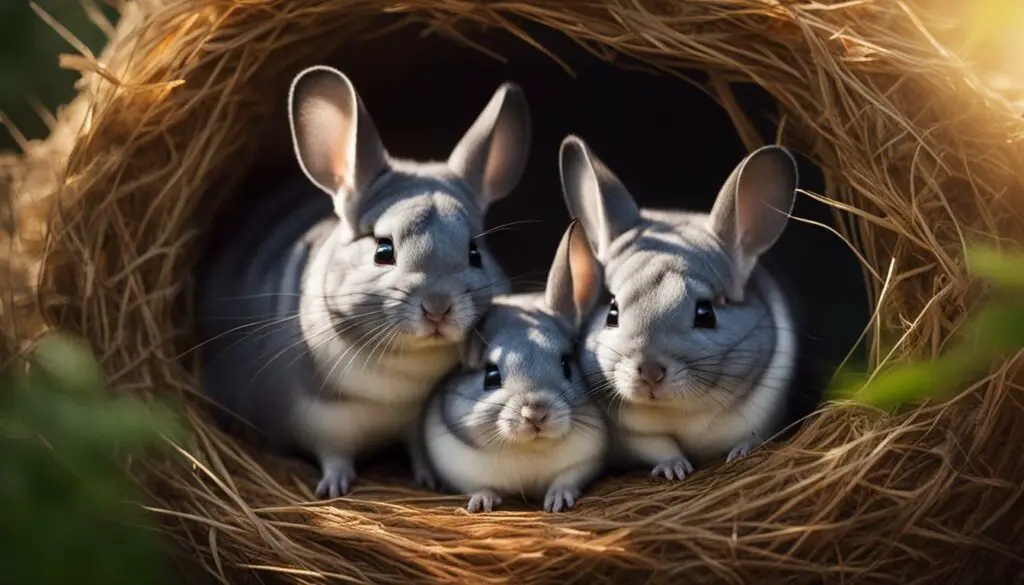
In conclusion, chinchillas thrive in the company of their fellow chinchillas, forming clowders that engage in playful behaviors and mutual grooming. Understanding their social behavior and providing the right environment is crucial for their overall well-being and happiness. By fostering a harmonious clowder of chinchillas, we can ensure these cute and cuddly companions live fulfilling lives.
Cats and Coyotes: Observing Their Interactions
Cats and coyotes are two species that occasionally cross paths in outdoor environments, leading to potential interactions between them. It is important for cat owners to be aware of the social behavior of coyotes and take necessary precautions to ensure the safety of their feline companions.
Coyotes are highly adaptable and can be found in a variety of habitats, including urban areas. They are opportunistic predators and scavengers, known for their resourcefulness. While coyotes primarily feed on small mammals like rodents and rabbits, they may view cats as potential prey in certain circumstances.
To minimize the risk of negative interactions between cats and coyotes, it is essential to keep cats indoors, especially during dawn and dusk when coyotes are most active. Providing a secure outdoor enclosure for cats can also allow them to enjoy fresh air and sunshine while remaining safe from potential predators.
It’s important to note that coyotes are intelligent and adaptive animals, and their behavior can vary depending on factors such as habitat, food availability, and human presence. While negative interactions between cats and coyotes are relatively rare, it is always best to prioritize the safety of our feline companions.
| Cat Safety Tips | Coyote Safety Tips |
|---|---|
|
|
By understanding the social behavior of coyotes and implementing safety measures, we can ensure a harmonious coexistence between cats and coyotes in their shared environments.
Dolphins and Cats: A Different Kind of Clowder
When it comes to unlikely friendships, the interaction between cats and dolphins is particularly fascinating. Dolphins are known for their high level of intelligence and social behavior, while cats are independent and curious creatures. Observing their interactions can provide us with insights into the dynamics of interspecies connections.
Dolphins, with their playful nature, are often drawn to the movement and agility of cats. Their curiosity leads them to approach cats in a friendly manner, engaging in a dance-like interaction. Cats, on the other hand, may be intrigued by the presence of dolphins, observing their graceful movements from a distance.
“The interaction between cats and dolphins is truly a sight to behold. I have witnessed cats sitting by the edge of the water, captivated by the dolphins’ acrobatics. It’s like they are watching a mesmerizing show,” says marine biologist Dr. Emily Johnson.
While these interactions may be intriguing to observe, it’s important to prioritize the safety and well-being of both animals. Cats should always be supervised near bodies of water to prevent any accidents, and dolphins should be given their space in their natural habitat.
| Behavior | Dolphins | Cats |
|---|---|---|
| Social Structure | Dolphins live in highly social groups known as pods, forming strong bonds with their pod members. | Cats are solitary by nature, although they can form social bonds with other cats or humans. |
| Communication | Dolphins communicate through a series of vocalizations, body movements, and even echolocation. | Cats communicate through a combination of vocalizations, body language, and pheromones. |
| Playfulness | Dolphins are known for their playful behavior, often engaging in acrobatics and games. | Cats are naturally playful animals, enjoying activities such as chasing toys and pouncing on objects. |
While the relationship between cats and dolphins may not involve direct physical interaction, it showcases the vastness of the animal kingdom and the potential for unexpected connections. The bond between these two species, though unique, reminds us of the universal language of curiosity and the wonders of the natural world.
Cats and Ferrets: Dynamic Duos
When it comes to the intriguing world of multi-species households, cats and ferrets make for an interesting dynamic duo. These two animals, each with their unique characteristics, can form a harmonious relationship based on their individual social behaviors and interactions.
Cat and ferret interactions can vary depending on the personalities of both animals. Cats, known for their hunting instincts, may see ferrets as potential prey. However, with proper introduction and socialization, cats can learn to view ferrets as companions rather than adversaries. It is important to supervise their interactions initially, providing a safe and controlled environment for both pets to get to know each other at their own pace.
Ferrets, on the other hand, are social creatures that enjoy play and exploration. They are naturally curious, which can pique a cat’s interest and create opportunities for engaging interactions. With their energetic and playful nature, ferrets can bring out the playful side of cats, resulting in a mutually entertaining relationship.
The Social Behavior of Ferrets
To better understand the dynamics between cats and ferrets, it is essential to delve into the social behavior of ferrets. Ferrets are highly social animals and thrive on companionship. They are known to form close bonds with both humans and other animals, making them an excellent companion for cats.
Ferrets engage in various social behaviors such as mutual grooming, play wrestling, and vocal communication. These behaviors are not only a means of establishing social bonds but also serve as a way to release excess energy and promote overall well-being. When cats and ferrets engage in these social behaviors together, it helps strengthen their bond and creates a sense of companionship.
As with any multi-species household, it is crucial to ensure the safety and well-being of both cats and ferrets. Providing separate spaces for each pet to retreat to when needed and supervising their interactions can help prevent any potential conflicts. With proper introduction and care, cats and ferrets can form a dynamic duo, bringing joy and entertainment to their human companions.
| Cat | Ferret |
|---|---|
| Known for hunting instincts | Social and playful nature |
| Can view ferrets as prey | Curious and energetic |
| Proper introduction and socialization needed | Engages in mutual grooming and play wrestling |
| Supervised interactions required | Forms close bonds with cats and humans |
| Separate spaces for retreat | Promotes companionship and well-being |
Foxes and Cats: A Mysterious Connection
When it comes to the relationship between foxes and cats, there is a certain air of mystery and intrigue. These two creatures, each with their own unique characteristics, have been known to interact in both urban and rural environments. Understanding the social behavior of foxes can shed light on their interactions with cats, providing valuable insights into this enigmatic connection.
Foxes are highly intelligent and adaptable animals, known for their cunning nature. They are also highly social creatures, living in small family groups called “leashes” or “skulks.” Within these groups, foxes exhibit complex hierarchies and engage in cooperative behaviors such as hunting and caring for their young. This social structure influences their interactions with other animals, including cats.
When a cat encounters a fox, their interaction can vary depending on factors such as the cat’s temperament and the fox’s level of curiosity. Some cats may be cautious and observant, while others may display more curiosity or even aggression. Similarly, foxes may approach cats with caution or curiosity, depending on their own experiences and the specific circumstances. These encounters can range from casual observations to brief interactions or even occasional playfulness.
“The interaction between cats and foxes is fascinating to observe. It’s like watching two equally intelligent and curious beings navigate their shared environment. Both cats and foxes have a natural curiosity about each other, which often leads to intriguing encounters. However, it’s important for cat owners to ensure the safety of their pets by keeping them indoors or supervised when in areas frequented by foxes.”
While the relationship between cats and foxes may remain shrouded in mystery, it is clear that their interactions can be both captivating and complex. By understanding the social behavior of foxes and the individual personalities of cats, we can appreciate the unique dynamics that unfold when these two creatures cross paths.
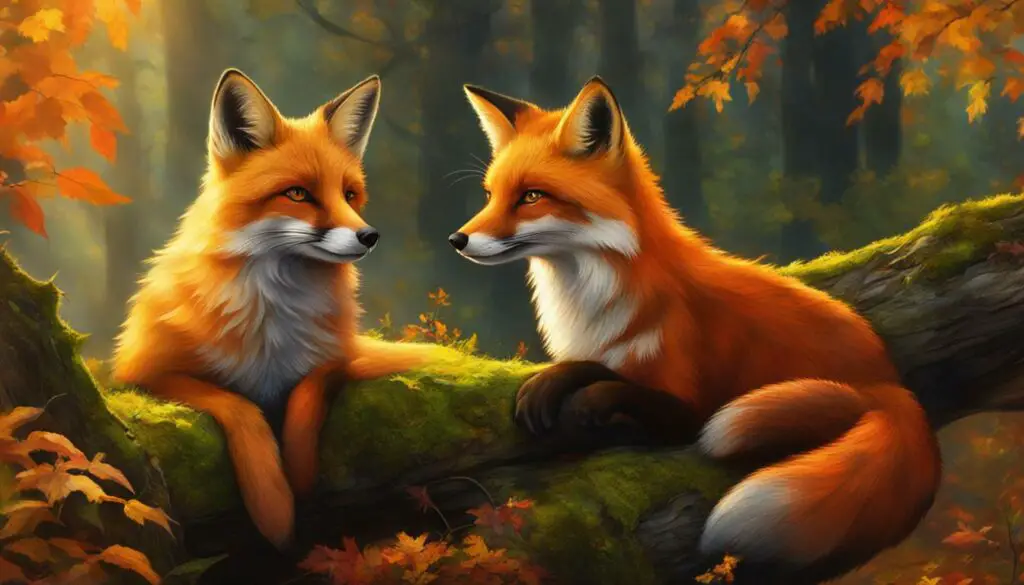
A Clowder of Guinea Pigs: Cuddly Companions
Guinea pigs are charming and sociable creatures that thrive in the company of their fellow furry friends. In fact, a group of guinea pigs is often referred to as a clowder, just like a cluster of cats. This collective noun perfectly captures the delightful sight of these cuddly companions munching on their hay, exploring their surroundings, and engaging in playful interactions.
When it comes to social behavior, guinea pigs exhibit fascinating dynamics within their clowder. They establish hierarchies and communicate through a variety of vocalizations, such as purring, squeaking, and chirping. This unique guinea pig language allows them to express their emotions and maintain harmony within the group.
Creating an enriching environment for a clowder of guinea pigs is essential for their well-being. Providing ample space, cozy hideouts, and stimulating toys encourages their natural behaviors and keeps them mentally stimulated. Additionally, offering plenty of fresh vegetables, hay, and high-quality guinea pig pellets ensures a nutritious diet for these adorable companions.
Table: Guinea Pig Social Behaviors
| Social Behavior | Description |
|---|---|
| Allogrooming | Guinea pigs groom each other as a bonding behavior, helping to strengthen social bonds within the clowder. |
| Popcorning | A joyful display of leaps and twists, popcorning is a sign of happiness and contentment among guinea pigs. |
| Chattering | When excited or eager, guinea pigs produce a unique chattering sound, signaling their anticipation. |
| Mounting | Mounting is a behavior that establishes dominance within the clowder hierarchy, and it can be seen among both males and females. |
| Wheeking | Guinea pigs use high-pitched wheeks to communicate their desires, such as when they are hungry or seeking attention. |
A clowder of guinea pigs is a delightful sight, showcasing the social and communal nature of these endearing pets. Their interactions and behaviors within the group add to their charm and make them beloved companions for animal lovers of all ages.
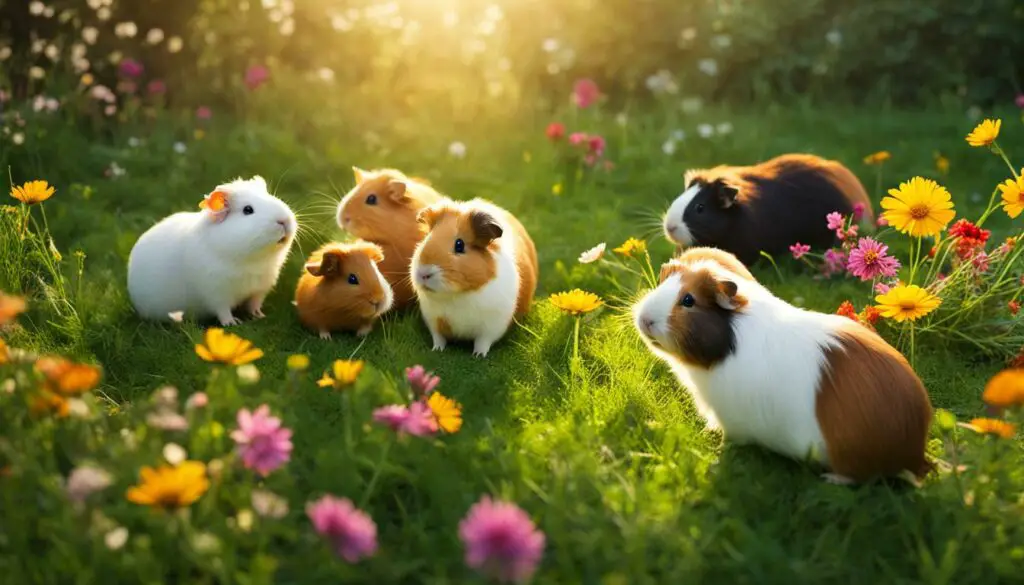
Overall, understanding the collective nature of guinea pigs and providing them with a nurturing environment allows us to appreciate their social behaviors and ensure their well-being. Whether it’s witnessing their allogrooming sessions, observing their playful popcorning, or simply enjoying their company, a clowder of guinea pigs brings joy and companionship into our lives.
Section 15: Conclusion
In my exploration of the intriguing dynamics between cats and pigs, I have discovered how these domesticated animals can coexist harmoniously in multi-species households. By understanding their behaviors, needs, and social structures, we can create a nurturing environment for both cats and pigs, ensuring their well-being and happiness.
Cats and pigs, although different in many ways, share a remarkable ability to form bonds and friendships with other animals. Whether it’s introducing cats to small rodents, rabbits, guinea pigs, or even cattle, careful consideration and supervision play a crucial role in establishing a safe and positive relationship.
Alongside these unexpected relationships, cats also have intriguing interactions with a variety of other creatures like cheetahs, dolphins, ferrets, foxes, and even coyotes. Each of these encounters provides us with a glimpse into the fascinating world of interspecies dynamics.
As pet owners, it is our responsibility to ensure the harmony and well-being of all the animals in our care. By understanding the unique dynamics between cats and pigs, and the potential for harmonious relationships in multi-species households, we can create a loving and inclusive environment for our furry companions.
FAQ
Can cats and small rodents coexist peacefully?
The compatibility between cats and small rodents depends on factors such as the temperament of the cat, the age of introduction, and the specific type of rodent. It is important to consider these factors to ensure a safe and harmonious multi-species household.
Can cats and rabbits become friends?
Yes, many pet owners have found success in fostering friendships between cats and rabbits. The initial meeting between the two should be carefully supervised, allowing the rabbit to take charge and assert their dominance. Gradual integration and supervised playtime can help establish a positive relationship.
How can I ensure the safety of both my cat and guinea pig?
To ensure the safety of both animals, it is important to securely lock the guinea pig’s cage and create a secure play area. Taking these precautions can help prevent any unintentional harm.
How can I create a safe environment for cats and small rodents like hamsters, rats, or mice?
Protecting hamsters with a secure cage and ensuring proper enclosures for rats and mice can help create a safe environment in a multi-species household.
What is a clowder of cats?
A clowder of cats refers to a group of cats coming together in unity and harmony. Each cat plays a unique role within the clowder, forming a cooperative unit that navigates their feline world together.
Can cats and cattle interact safely?
While unexpected, cats and cattle may have interactions. It’s important to consider their compatibility and safety in shared spaces.
Do cats and cheetahs interact with each other?
While cats and cheetahs may encounter each other in certain settings, their interactions can depend on their social structure and behavior. Understanding cheetah social behavior can provide insights into potential interactions with domestic cats.
What is a clowder of chinchillas?
A clowder of chinchillas refers to a group of chinchillas coming together in a communal behavior such as eating and playing. Observing their social behavior can enhance our appreciation for these adorable pets.
How can I protect both my cat and coyotes in outdoor environments?
Cats and coyotes may encounter each other in outdoor environments. Understanding coyote behavior and taking precautions can help ensure the safety of both animals.
Do cats and dolphins interact with each other?
While unexpected, cats and dolphins may have interactions. Exploring the interactions between cats and dolphins can provide interesting insights into interspecies dynamics.
Can cats and ferrets form a harmonious relationship?
Cats and ferrets can form dynamic duos. Understanding their social behavior can help facilitate a harmonious relationship between the two.
What should I know about cats and foxes interacting in outdoor environments?
Cats and foxes may encounter each other in outdoor environments. Taking into account the social behavior of foxes can provide insights into potential interactions with cats.
Can cats and guinea pigs interact positively?
A clowder of guinea pigs can be a delightful sight, with these cuddly creatures engaging in communal behavior. Understanding their social behavior can enhance our appreciation for these adorable pets.

